Research Report on the Application of AI in Automotive Cockpits, 2025
Cockpit AI Application Research: From "Usable" to "User-Friendly," from "Deep Interaction" to "Self-Evolution"
From the early 2000s, when voice recognition and facial monitoring functions were first integrated into vehicles, to the rise of the "large model integration" trend in 2023, and further to 2025 when automakers widely adopt the reasoning model DeepSeek-R1, the application of AI in cockpits has evolved through three key phases:
Pre-large model era: Cockpits transitioned from mechanical to electronic and then to intelligent systems, integrating small AI models for scenarios like facial and voice recognition.
Post-large model era: AI applications expanded in scope and quantity, with significant improvements in effectiveness, though accuracy and adaptability remained inconsistent.
Multimodal large language models (LLMs) and reasoning models: Cockpits advanced from basic intelligence to a stage of "deep interaction and self-evolution."
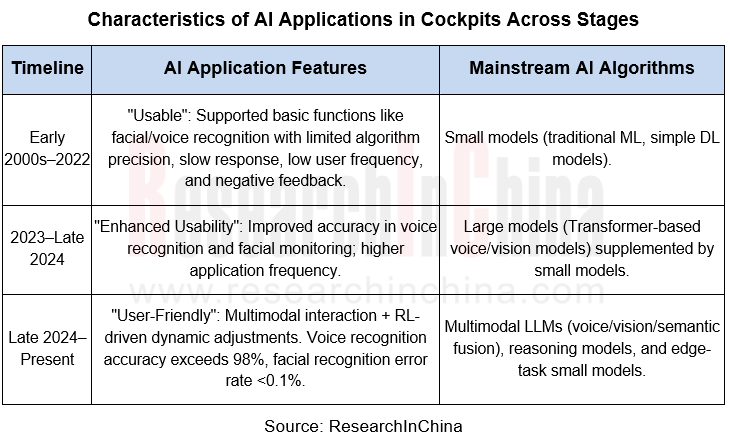
ResearchInChina has sorted out the application scenarios of AI in different cockpit component systems, some of which are shown in the table:
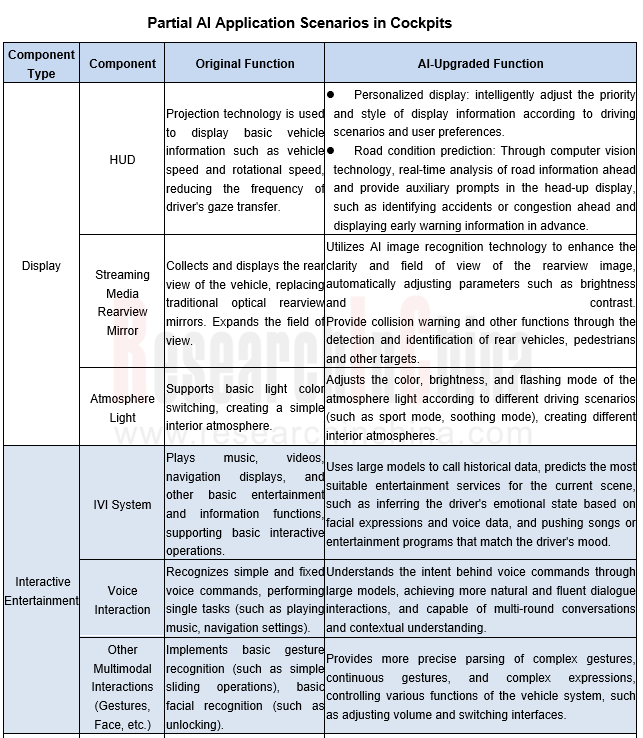
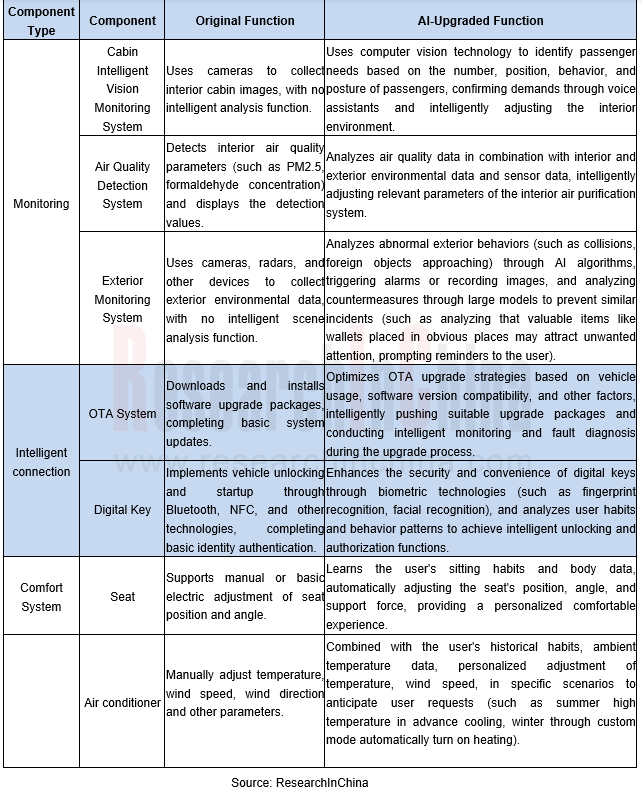
Cockpit AI Development Trend 1: Deep Interaction
Deep interaction is reflected in "linkage interaction", "multi-modal interaction", "personalized interaction", "active interaction" and "precise interaction".
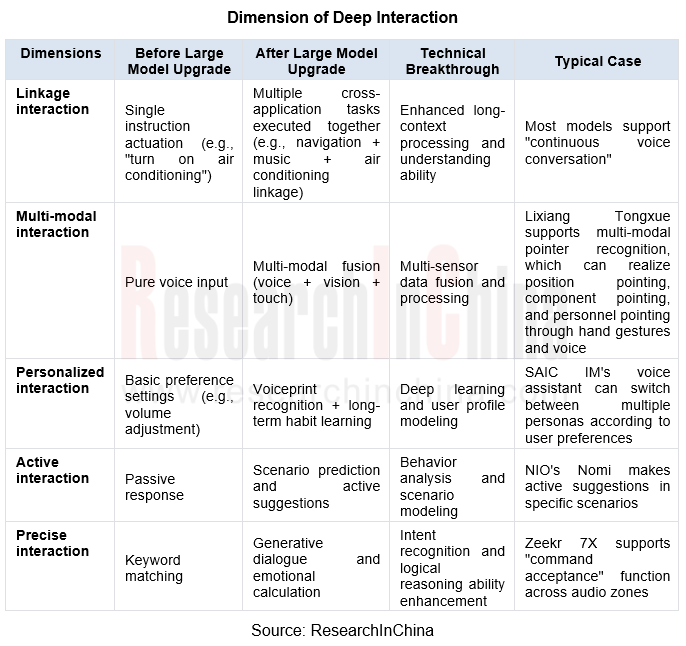
Taking "precise interaction" as an example, the inference large model not only improves the accuracy of voice interaction, especially the accuracy of continuous recognition, but also through dynamic understanding of context, combined with sensor fusion processing data, relying on multi-task learning architecture to synchronously process navigation, music and other composite requests, and the response speed is increased by 40% compared with traditional solutions. It is expected that in 2025, after the large-scale loading of inference models (such as DeepSeek-R1), end-side inference capabilities can make the automatic speech recognition process faster and further improve the accuracy.
Taking "multi-modal interaction" as an example, using the multi-source data processing capabilities of large models, a cross-modal collaborative intelligent interaction system can be built. Through the deep integration of 3D cameras and microphone arrays, the system can simultaneously analyze gesture commands, voice semantics and environmental characteristics, and complete multi-modal intent understanding in a short time, which is 60% faster than traditional solutions. Based on the cross-modal alignment model, gesture control and voice commands can be coordinated to further reduce the misoperation rate in complex driving scenarios. It is expected that in 2025-2026, multi-modal data fusion processing capabilities will become standard in the new generation of cockpits. Typical scenarios include:
Gesture control: Drivers can conveniently control functions such as windows, sunroof, volume, navigation, etc. through simple gestures, such as waving, pointing, etc., without distracting their driving attention.
Facial recognition and personalization: The system can automatically identify the driver through facial recognition technology, and automatically adjust the settings of seats, rearview mirrors, air conditioners, music, etc. according to their personal preferences, to achieve a personalized experience of "get in the car and enjoy".
Eye tracking and attention monitoring: Through eye tracking technology, the system can monitor the driver's gaze direction and attention state, detect risk behaviors such as fatigue driving and inattention in a timely manner, and provide early warning prompts to improve driving safety.
Emotional recognition and emotional interaction: AI systems can even identify the driver's emotional state, such as judging whether the driver is anxious, tired or excited through facial expressions, voice tone, etc., and adjust the ambient lighting, music, air conditioning, etc. in the car accordingly to provide more intimate emotional services.
Cockpit AI Development Trend 2: self-evolution
In 2025, the cockpit agent will become the medium for users to interact with the cockpit, and one of its salient features is "self-evolution", reflected in "long-term memory", "feedback learning", and "active cognition".
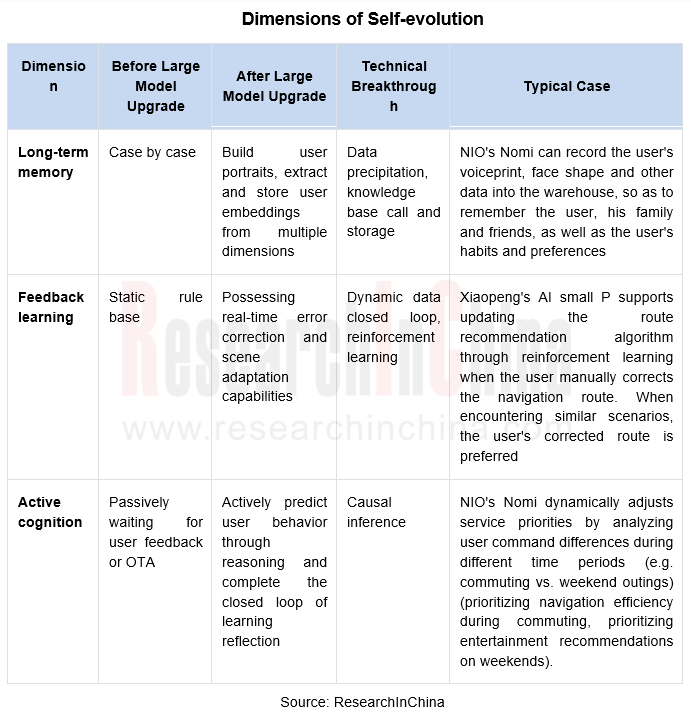
“Long-term memory”, “feedback learning”, and “active cognition” are gradual processes. AI constructs user portraits through voice communication, facial recognition, behavior analysis and other data to achieve “thousands of people and thousands of faces” services. This function uses reinforcement learning and reasoning related technology implementation, and the system relies on data closed-loop continuous learning of user behavior. Under the reinforcement learning mechanism, each user feedback becomes the key basis for optimizing the recommendation results.
With the continuous accumulation of data, the large model can more quickly discover the law of user interest point transfer, and can anticipate user requests in advance. It is expected that in the next two years, with the help of more advanced reinforcement learning algorithms and efficient reasoning architecture, the system will increase the mining speed of users’ new areas of interest by 50%, and the accuracy of recommended results will be further improved. Such as:
BMW’s cockpit system remembers driver seat preferences, frequented locations, and automatically dims ambient lights to relieve anxiety on rainy days;
Mercedes-Benz’s voice assistant can recommend restaurants based on the user’s schedule and reserve charging stations in advance.
BMW Intelligent Voice Assistant 2.0 is based on Amazon’s Large Language Model (LLM) and combines the roles of personal assistant, vehicle expert and accompanying occupant to generate customized suggestions by analyzing the driver’s daily route, music preferences and even seat adjustment habits. For example, if the system detects that the driver often stops at a coffee shop every Monday morning, it will proactively prompt in a similar situation: “Are you going to a nearby Starbucks?” In addition, the system can also adjust recommendations based on weather or traffic conditions, such as recommending indoor parking on rainy days; when the user says “Hello BMW, take me home”, “Hello BMW, help me find a restaurant”, the personal assistant can quickly plan a route and recommend a restaurant.
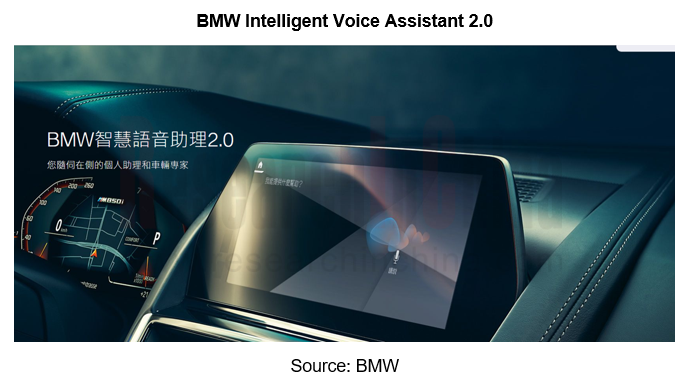
Cockpit AI Development Trend 3: Symbiosis of Large and Small Models
The large model has been on the bus for nearly two years, but the phenomenon of the large model “completely replacing” the small model has not occurred. With its lightweight and low power consumption characteristics, the small model performs well in end-side task scenarios with high real-time requirements and relatively small data processing. For example, in intelligent voice interaction, the small model can quickly parse commands such as “turn on the air conditioner” or “next song” to provide instant responses. Similarly, in gesture recognition, the small model realizes low-latency operation through local computing, avoiding the time lag of cloud transmission. This efficiency makes the small model the key to improving the user interaction experience.
In practical applications, the two complement each other; the large model is responsible for complex calculations in the background (such as path planning), while the small model focuses on the fast response of the front desk (such as voice control), jointly building an efficient and intelligent cockpit ecosystem. Especially inspired by DeepSeek’s distillation technology, it is expected that after 2025, the end-side small models obtained by distilling high-performance large models will be mass-produced on a certain scale.”
Taking NIO as an example, it runs its AI application in a two-wheel drive manner for large and small models as a whole, with a focus on large models, but it does not ignore the application of small models.
Autonomous Driving Domain Controller and Central Computing Unit (CCU) Industry Report, 2025
Research on Autonomous Driving Domain Controllers: Monthly Penetration Rate Exceeded 30% for the First Time, and 700T+ Ultrahigh-compute Domain Controller Products Are Rapidly Installed in Vehicles
L...
China Automotive Lighting and Ambient Lighting System Research Report, 2025
Automotive Lighting System Research: In 2025H1, Autonomous Driving System (ADS) Marker Lamps Saw an 11-Fold Year-on-Year Growth and the Installation Rate of Automotive LED Lighting Approached 90...
Ecological Domain and Automotive Hardware Expansion Research Report, 2025
ResearchInChina has released the Ecological Domain and Automotive Hardware Expansion Research Report, 2025, which delves into the application of various automotive extended hardware, supplier ecologic...
Automotive Seating Innovation Technology Trend Research Report, 2025
Automotive Seating Research: With Popularization of Comfort Functions, How to Properly "Stack Functions" for Seating?
This report studies the status quo of seating technologies and functions in aspe...
Research Report on Chinese Suppliers’ Overseas Layout of Intelligent Driving, 2025
Research on Overseas Layout of Intelligent Driving: There Are Multiple Challenges in Overseas Layout, and Light-Asset Cooperation with Foreign Suppliers Emerges as the Optimal Solution at Present
20...
High-Voltage Power Supply in New Energy Vehicle (BMS, BDU, Relay, Integrated Battery Box) Research Report, 2025
The high-voltage power supply system is a core component of new energy vehicles. The battery pack serves as the central energy source, with the capacity of power battery affecting the vehicle's range,...
Automotive Radio Frequency System-on-Chip (RF SoC) and Module Research Report, 2025
Automotive RF SoC Research: The Pace of Introducing "Nerve Endings" such as UWB, NTN Satellite Communication, NearLink, and WIFI into Intelligent Vehicles Quickens
RF SoC (Radio Frequency Syst...
Automotive Power Management ICs and Signal Chain Chips Industry Research Report, 2025
Analog chips are used to process continuous analog signals from the natural world, such as light, sound, electricity/magnetism, position/speed/acceleration, and temperature. They are mainly composed o...
Global and China Electronic Rearview Mirror Industry Report, 2025
Based on the installation location, electronic rearview mirrors can be divided into electronic interior rearview mirrors (i.e., streaming media rearview mirrors) and electronic exterior rearview mirro...
Intelligent Cockpit Tier 1 Supplier Research Report, 2025 (Chinese Companies)
Intelligent Cockpit Tier1 Suppliers Research: Emerging AI Cockpit Products Fuel Layout of Full-Scenario Cockpit Ecosystem
This report mainly analyzes the current layout, innovative products, and deve...
Next-generation Central and Zonal Communication Network Topology and Chip Industry Research Report, 2025
The automotive E/E architecture is evolving towards a "central computing + zonal control" architecture, where the central computing platform is responsible for high-computing-power tasks, and zonal co...
Vehicle-road-cloud Integration and C-V2X Industry Research Report, 2025
Vehicle-side C-V2X Application Scenarios: Transition from R16 to R17, Providing a Communication Base for High-level Autonomous Driving, with the C-V2X On-board Explosion Period Approaching
In 2024, t...
Intelligent Cockpit Patent Analysis Report, 2025
Patent Trend: Three Major Directions of Intelligent Cockpits in 2025
This report explores the development trends of cutting-edge intelligent cockpits from the perspective of patents. The research sco...
Smart Car Information Security (Cybersecurity and Data Security) Research Report, 2025
Research on Automotive Information Security: AI Fusion Intelligent Protection and Ecological Collaboration Ensure Cybersecurity and Data Security
At present, what are the security risks faced by inte...
New Energy Vehicle 800-1000V High-Voltage Architecture and Supply Chain Research Report, 2025
Research on 800-1000V Architecture: to be installed in over 7 million vehicles in 2030, marking the arrival of the era of full-domain high voltage and megawatt supercharging.
In 2025, the 800-1000V h...
Foreign Tier 1 ADAS Suppliers Industry Research Report 2025
Research on Overseas Tier 1 ADAS Suppliers: Three Paths for Foreign Enterprises to Transfer to NOA
Foreign Tier 1 ADAS suppliers are obviously lagging behind in the field of NOA.
In 2024, Aptiv (2.6...
VLA Large Model Applications in Automotive and Robotics Research Report, 2025
ResearchInChina releases "VLA Large Model Applications in Automotive and Robotics Research Report, 2025": The report summarizes and analyzes the technical origin, development stages, application cases...
OEMs’ Next-generation In-vehicle Infotainment (IVI) System Trends Report, 2025
ResearchInChina releases the "OEMs’ Next-generation In-vehicle Infotainment (IVI) System Trends Report, 2025", which sorts out iterative development context of mainstream automakers in terms of infota...